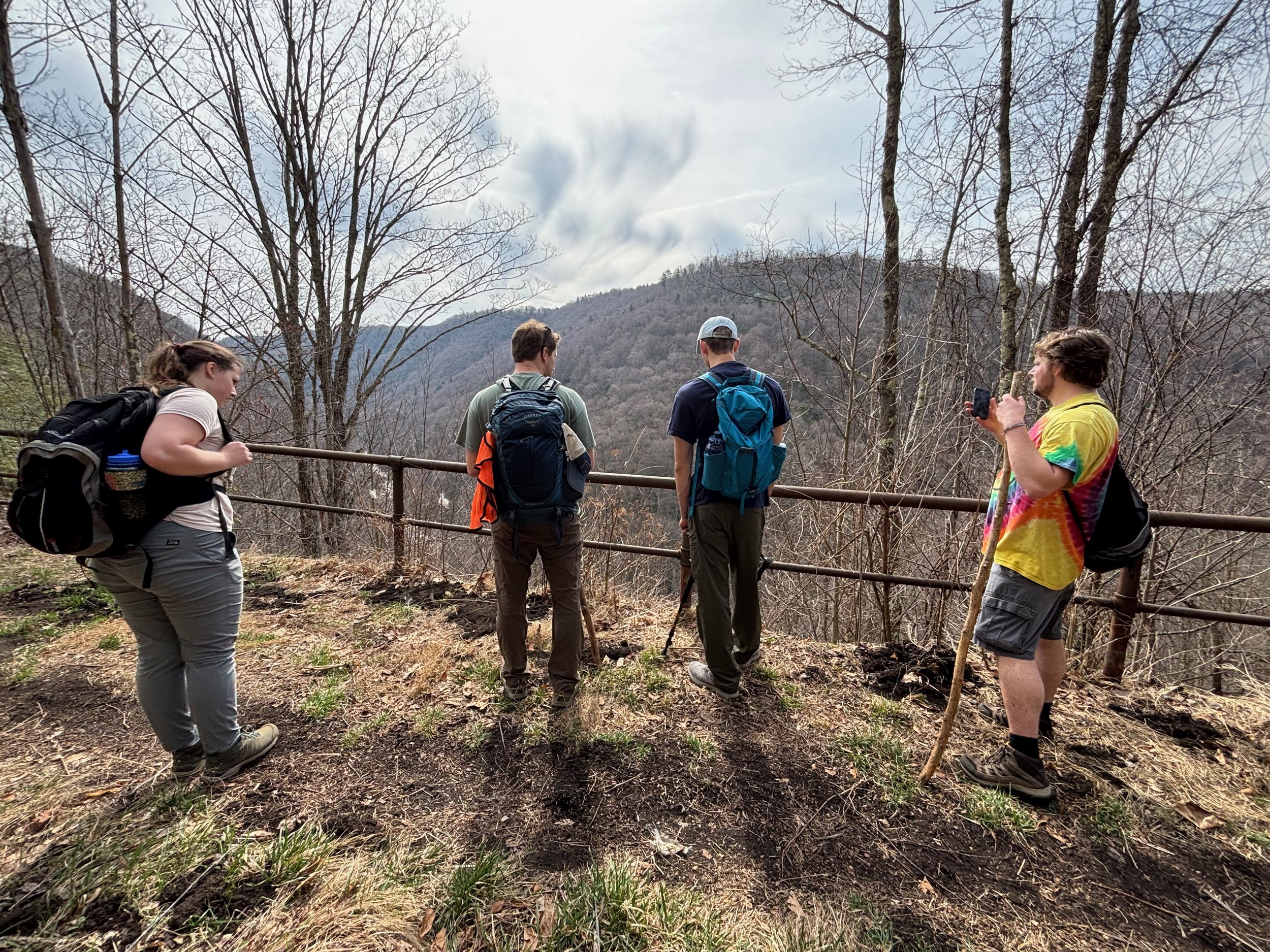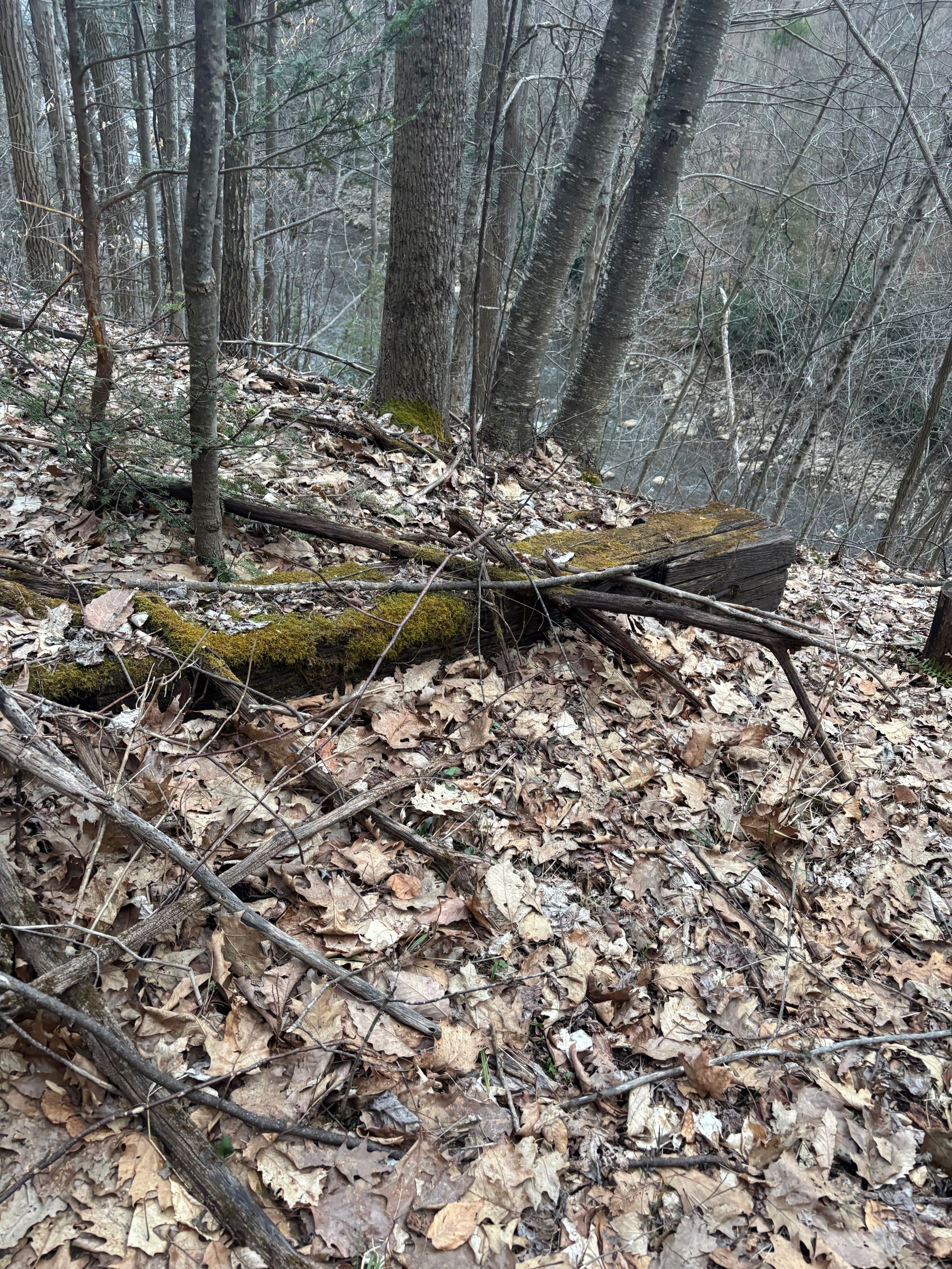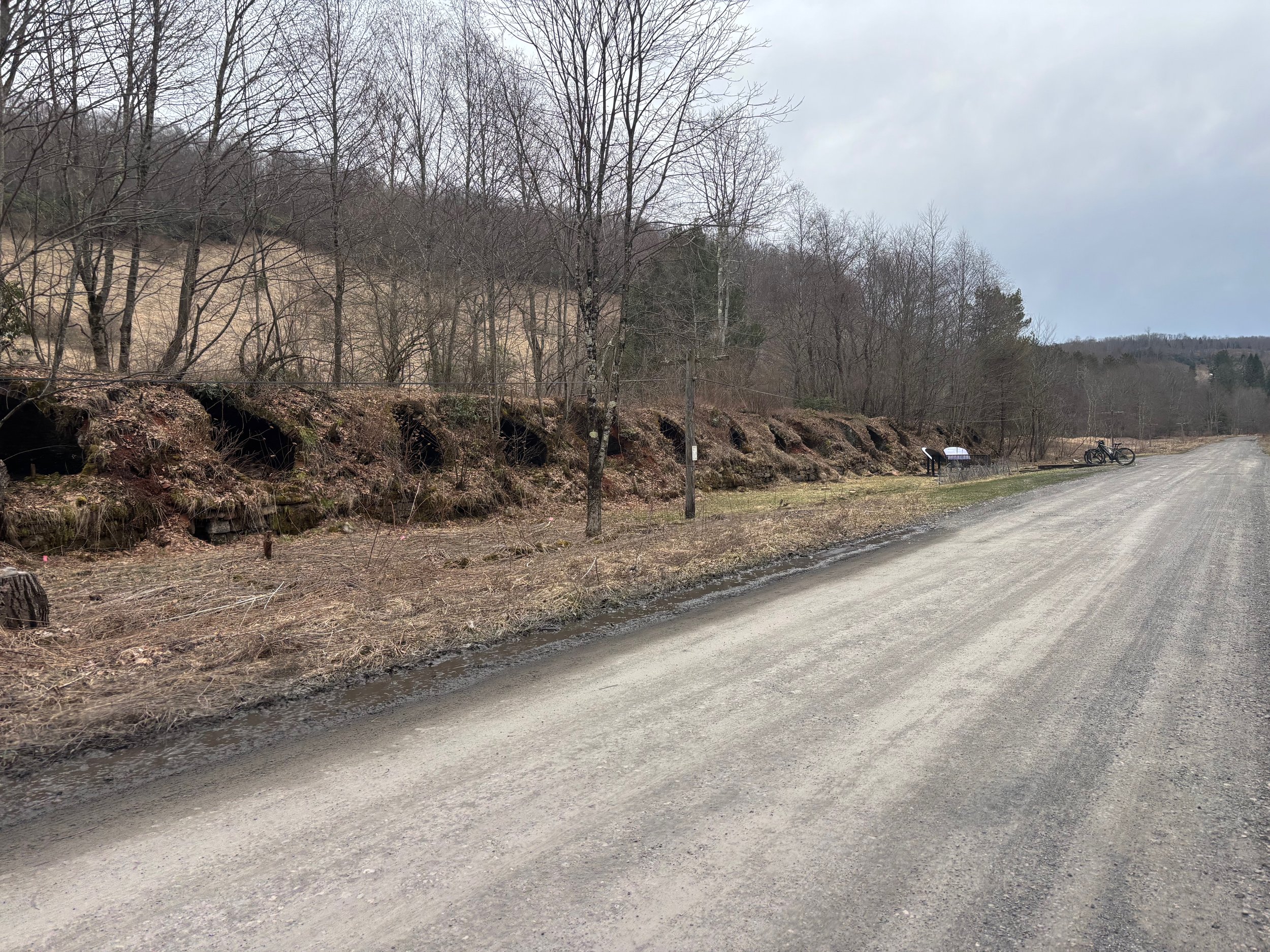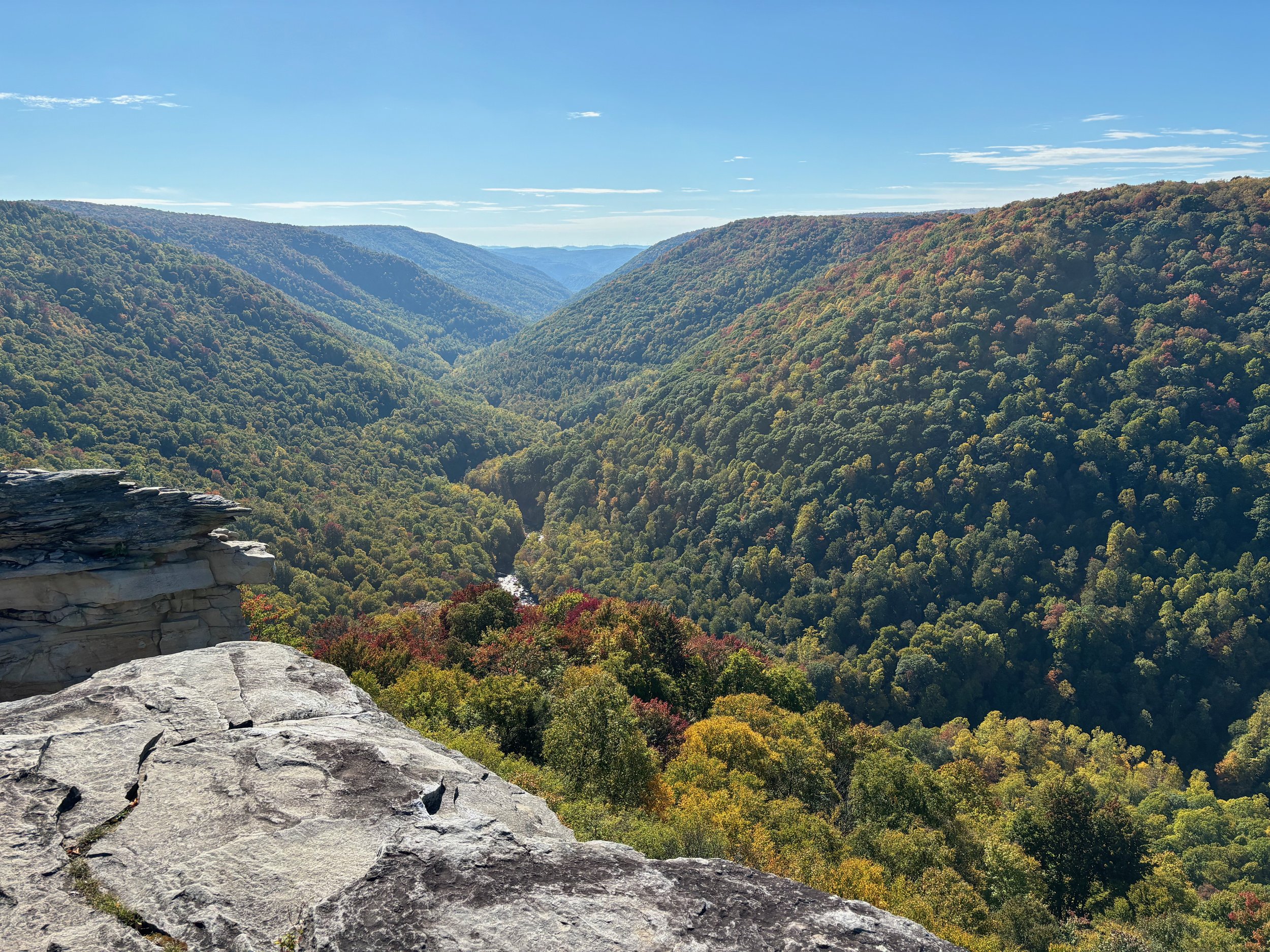By Kieran Adams Serving with the Appalachian Forest National Heritage Area
The PeasantWalk crew at 8:15 AM, from left to right: Me (Kieran), Madeline, Daniel, Tucker, and Trent
Historians say a medieval peasant would walk up to twenty miles in a day to reach a market. This single fact enraptured us since it was first mentioned by Tucker on a long trek through the bog of Dolly Sods one fall afternoon. While at first it gnawed benignly like a worm in the back of our heads, it swelled to an obsession during the winter until it burst into being on a warm afternoon in March as PeasantWalk 2025. The journey would be a twenty-mile hike up and down the Blackwater Canyon Trail in Tucker County, with Hellbender Burritos in the town of Davis as the “market” in mind. The date was set for March 15th, as the seminal food spot of Canaan Valley would close for good a day later.
While we drove along the windy, bison-carved roads of Route 219 to the trailhead at Parsons, we watched the sun rise slowly and fill the sky with pastel blues and pinks. The Monongahela National Forest never fails to provide moments of meditative wonder. As we mentally prepared for a hike that would last until the sun returned to the mountains, I had a Robert Frost poem stuck in my mind.
The woods are lovely, dark and deep,
But I have promises to keep,
And miles to go before I sleep,
And miles to go before I sleep.
Train wreck in the Blackwater Canyon, via West Virginia History OnView
We started out on the first several miles of the trail with an industrious enthusiasm. The Blackwater Canyon Trail follows an old railroad path that ascended 1300 feet of elevation in the Blackwater Canyon in a little over ten miles. While the locomotives that traveled the canyon faced a steep and twisting grade with the chilling danger of derailment into the abyss, for us peasants the climb was almost negligible. So unlike our smoke-billowing predecessors, our ascent was a matter of steady persistence.
Along the way we discussed the themes of the Appalachian Forest National Heritage Area which were frequently mentioned during our AmeriCorps orientation. On the Canyon trail the themes come naturally anyways. The trail itself is a remnant of the industrious boom of the region’s past. As we travelled along it we found thick railroad ties cast aside and rotting, cut from the giant trunks of old-growth forests. The expanse of second growth trees around us are a stark contrast to the landscape we would have seen in the canyon around one-hundred years ago, a bare deforested valley.
Railroad tie on the Canyon trail
Deforested Blackwater Canyon, via West Virginia History OnView
Daffodils
As we sunk deeper into the wilderness, the “Crucible of Isolation” of the Appalachian Forest became apparent. While the greenery was limited in mid-March, daffodils poked up in patches. Daniel pointed out that daffodil patches were often a marker of European settlements, as the early mountaineers had brought the non-native bulbs from overseas. For some of these immigrants, life in the mountains was an escape from their peasant lifestyle in the old country, where they were bound to land and subject to the obligations of nobles. The dense Appalachian Forest provided them obscurity from landowning elites. Our (ahistoric) peasant pilgrimage would have been akin to daily life in a time when getting places, be it the market or tavern, meant going on foot through the woods.
The trail follows the Blackwater River, and then its North Fork into Thomas. The name of the river derives from the color imbued by soaked needles of spruce and hemlock trees. As we turned onto the North Fork and neared Thomas, the tea-colored water washed over vibrantly stained rocks. This discoloration is a byproduct of the town’s industrial past. The railroad that traveled the Blackwater Canyon was built with the burgeoning businesses of Thomas and Davis in mind, which were hotspots of coal mining and timbering respectively. Acid mine drainage from the Thomas coal mines has since seeped into the watershed, and caused the orange staining of the rocks and streams beside the trail approaching the town.
Stained rocks at Douglas Falls
We entered the company town of Coketon, right before Thomas, where industrial monuments emerged. Both sides of the river were dotted with rows and rows of coke ovens, beehive-shaped brick structures used to burn coal into coke, a purer fuel for smelting steel. Now, as the trail has supplanted the railroad tracks, the forest is reclaiming the ovens. Mosses, ferns, and decomposing leaf litter shroud the lines of ovens that once were lit like lanterns along the railroad, 600 total, spouting black fumes into the canyon. As the ovens sink into the landscape, you can't help but feel a sense of awe for the forest’s resilience. Humanity has to clean up our mess too, which the Friends of the Blackwater lead by example in their efforts to mitigate acid mine drainage in the Blackwater watershed.
Coke ovens along the Canyon trail
So long Hellbender!
Once we passed the coke ovens we were on the final push into Thomas. Some of us took off running to reach our stashed car. Hellbenders lay just a town over and after ten miles we were famished. As we gorged on the plump and nourishing burritos we were surrounded by the iconography of the famed hellbender, a giant salamander that lives in the Appalachian mountains. The hellbender is a remarkable example of the wonders of biodiversity and the unique ecosystems that support it. What push and pull factors of evolution, rapid changes or slow creeping adaptations created this flabby amphibian the size of our forearms? It’s quite a magical forest we live in; picture us peons, surrounded by monsters from hell!
Eastern Hellbender, via Tim Tiburzi
After exploring the town of Davis, browsing art shops, chatting with artisans, and tasting maple syrup, we returned to our hike. The back-again portion was all downhill and the Hellbender burritos had shoveled fuel into our bodies like coal in a coke oven. We passed landmarks like Lindy Point, which was across the canyon on the Blackwater Falls State Park side. It was hard to reconcile the two images in my head, one from the commanding lookout of Lindy Point into an endless valley and the other, where the lookout is a tiny slab enveloped by trees. While it is hard to beat Lindy’s views, the feeling on the Canyon Trail is less about grandiosity and more a sense of subtle beauty: the unique rock formations caused by dripping water, the canopies of verdant Rhododendrons that droop but never shed in the winter, and the series of waterfalls along the way that pour into the Blackwater. While we couldn’t see the vast expanse of the canyon, within it we could peer into the most minute peculiarities.
View from Lindy Point
Lindy Point from the Canyon trail
Daylight faded as we picked up the pace for the last miles of our journey. The slow nagging exhaustion of hours and hours of hiking would have to take a backseat to our determined march forward. The woods were truly lovely, dark, and deep. When the car we left in Parsons finally appeared from the nighttime haze we hollered and again broke into a sprint. By then it was 8:00 PM, almost twelve hours since we first set out. We piled in and drove back to Thomas, to pick up the Thomas car and two pizzas from Sirianni’s in Davis. It was a fitting end to our night, with 20+ miles under our belt, to sink our teeth into a crisp Sirianni’s crust. Our adventure in the Appalachian Forest was over for the day but more awaited. There are always so many more miles to go before we sleep.
PeasantWalk completed!
















